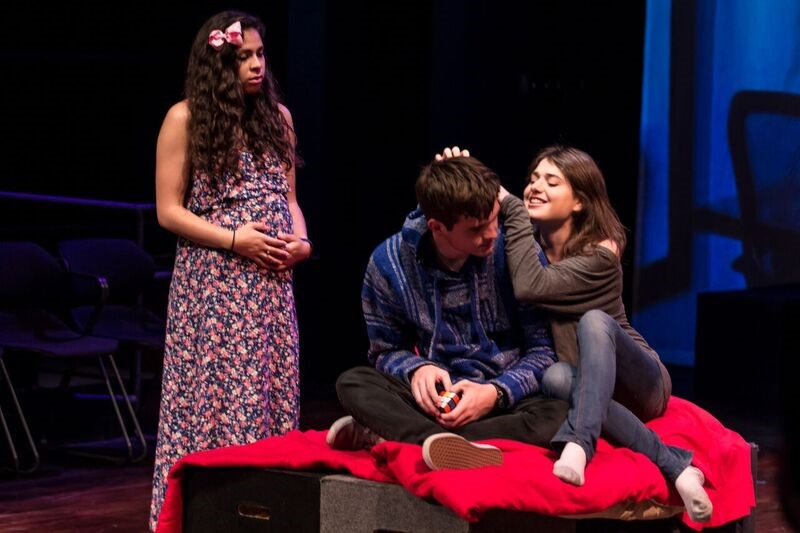
By Eva Trieger

SAN DIEGO — Once again the Playwrights Project proves that it is not afraid to tackle thorny subjects that most would like to sweep under the rug. Just as the group partnered with the Richard J. Donovan Correctional Facility to bring us Out of the Yard, last year, they have created Other People’s Kids and companion piece, Finding our Way , to shed light on the pervasive methamphetamine problem facing today’s youth. This unusual play was the brainchild and collaborative effort of several organizations in response to the vast number of arrests for methamphetamine related crimes in San Diego. The initiative brought the US Attorney’s office into an alliance with Social Advocates for Youth (SAY San Diego) and the Playwrights Project.
This dedicated group commissioned Mabelle Reynoso to write this play that tracked the lives of four teenagers who are impacted by the drug, and forever altered. The message is simple while the tale is multi-tiered: ANYONE can fall prey to drug addiction. The affliction knows no economic, social, political or racial boundary. Other People’s Kids illustrated that the insidious drug culture is completely indiscriminate when selecting its victims.
Now in its fifth year, the Playwrights Project has teamed up with San Diego State University to unite the campus and community partners. These allies work together to heighten understanding of community issues, and bring them to audiences through dramatic representation. Support for the production is garnered from McAlister Foundation, The James Irvine Foundation, The William James Association Prison Arts Project, California Arts Council, City of San Diego Commission for Arts and Culture, and the State of California Department of Corrections and Rehabilitation. Cecelia Kouma, Playwrights Project Executive Director, introduced the panel and facilitated an audience Q and A.
As riveting as the play was the talk back that followed each performance. The experts who spoke on the day I attended included Associate Professor Peter Cirino, who directed the student actors; Mabelle Reynoso, playwright and teaching artist with Donovan Correctional Facility; and Laurie Brooks, who addressed community involvement. Dr. Heather Greenwald was also on deck and stated that the performances were “painfully authentic” and further reminded that the “arts can help heal” those who suffer from addiction. Robert Brown, Community Resource Manager for the Richard J. Donovan Correctional Facility, lent his support and commendation of both the student actors, contributors and the men who are undergoing rehabilitation at his center.
A spare set served as the backdrop for the revealing stories of young people who succumbed to the methamphetamine siren song. A few common themes emerged. There were overwhelming similarities among the teens though they were quite different from each other. MacKenzie (Paige Jensen), an upper middle class straight-A student, bound for Brown University, felt alienated and isolated. Her own mother (Alex DeMarco) worried that she was not “social” enough, too much of a bookworm. The girl felt herself a pariah and so in her last semester of high school was inducted into the drug world, and swallowed by its seduction of ephemeral emotional relief.
Another young woman, Gaby (Destiny Girley), had served time for her drug use, and was trying to get clean for herself and for the unborn child she carried. She struggled with a boyfriend, Jesse, (Nick Sandoval), who was a dealer and user. Two other teens were caught up in the web, Sammy (Ross Graham) and Aaron (Adam Gilmore), spiraling downwards and losing touch with family, friends and their lives. Each character spoke of his/her sense of not fitting in, exhaustion and hopelessness at ever regaining a sense of self and purpose.
The second act, Finding our Way, presented the collaborative efforts of residents of the Richard J. Donovan Facility, supported by James Pillar, Mabelle Reynoso and Cecelia Kouma. This piece encouraged the viewer to see what causes one to become addicted. The responses provided include feeling awkward or disconnected; fighting painl become “creative;” to fit in to social events; to stay awake for self-defense if one lives on the street, and to forget a reality that is too heinous to recall.
A few quotes really affected me. In the discussion of addiction one man stated that it’s “like a chimpanzee gone mad.” Another expressed it “as if I’m in a race from me to me.” Both of those I found deeply disturbing and horribly sad. The dialogue of the men from Donovan encouraged us to see, “I’m not an addict; I’m a person who struggles with addiction.” Indeed, the message is universal, and the emphasis was on the notion that the problem is pervasive and insidious. “I could be your brother, mother, daughter, neighbor, boss….anyone.”
The plays end with the characters offering up alternative solutions they believe are far more effective than incarceration and may actually deliver a humane response. Each actor stood and offered a word or phrase before falling to the ground. The alternative solutions close out the show with hope, peace, optimism and a sense that it’s not a done deal. The realization that combined love and support for the addicted and a deeper understanding of the addiction, may lead us toward a bridge of healing.
*
Trieger is a freelance writer specializing in coverage of the arts. She may be contacted via eva.trieger@sdjewishworld.com